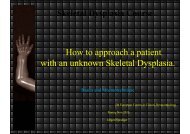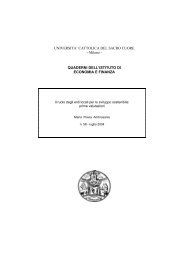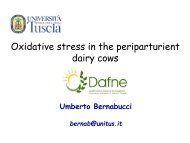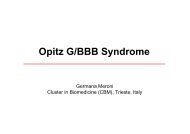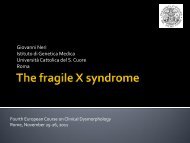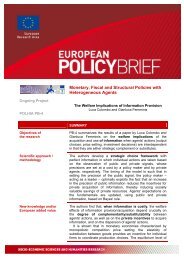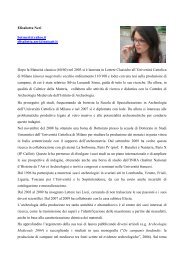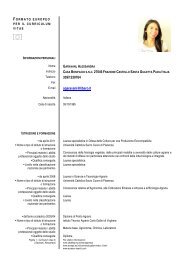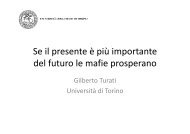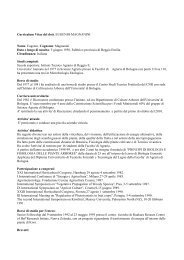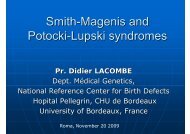What I Know Best: Holoprosencephaly - Istituti
What I Know Best: Holoprosencephaly - Istituti
What I Know Best: Holoprosencephaly - Istituti
You also want an ePaper? Increase the reach of your titles
YUMPU automatically turns print PDFs into web optimized ePapers that Google loves.
<strong>What</strong> I <strong>Know</strong> <strong>Best</strong>:<br />
<strong>Holoprosencephaly</strong><br />
Max Muenke<br />
Medical Genetics Branch<br />
National Human Genome Research Institute<br />
National Institutes of Health<br />
BBethesda, th d MMaryland, l d USA<br />
mamuenke@mail.nih.gov<br />
Second European Course in Clinical Dysmorphology<br />
Rome, March 28-29, 2008
Clinical Projects j<br />
• <strong>Holoprosencephaly</strong><br />
• ADHD<br />
QuickTime and a<br />
TIFF (LZW) decompressor<br />
are needed to see this picture.<br />
• “M “Muenke” k ” syndrome<br />
d<br />
QuickTime and a<br />
TIFF (LZW) decompressor<br />
are needed to see this picture.
<strong>Holoprosencephaly</strong> (HPE)
Nodal and Hedgehog Signaling<br />
FOXH1<br />
SIX3<br />
NODAL<br />
TDGF1<br />
DISP1<br />
TGIF<br />
SHH<br />
PTC<br />
ZIC2<br />
LLow<br />
Cholesterol<br />
GLI2<br />
CDO
Sonic Hedgehog,<br />
Hedgehog<br />
Cholesterol,<br />
Brain Development,<br />
and Prematurity
H<strong>Holoprosencephaly</strong> l h l (HPE)<br />
• Midline Defect of the Developing Forebrain<br />
and Face<br />
• Prevalence: 1 in 250 Early Embryos<br />
1 in 10,000 , Live-born Live born Infants<br />
less than 1:100,000 over 1 Y/O<br />
• Etiology: Extremely Heterogeneous
Alobar HPE<br />
Semilobar HPE
<strong>Holoprosencephaly</strong><br />
p p y<br />
“The Face Predicts the Brain”
<strong>Holoprosencephaly</strong> Gene Carriers
Causes of HPE<br />
• Cytogenetic Cytogenetic Anomalies<br />
• Gene Mutations<br />
• Defects of Cholesterol Biosynthesis<br />
• G Gene/Environment /E i t Interactions<br />
I t ti
Causes of HPE<br />
• Cytogenetic Cytogenetic Anomalies<br />
• Gene Mutations<br />
• Defects of Cholesterol Biosynthesis<br />
• G Gene/Environment /E i t Interactions<br />
I t ti<br />
Low maternal cholesterol?<br />
Maternal diabetes?<br />
Alcohol exposure?<br />
p<br />
Retinoic acid exposure?
Cytogenetic Anomalies in HPE
Positional Cloning of HPE Genes<br />
DISPATCHED<br />
HNF3β? β TGIF<br />
SIX3<br />
ZIC2<br />
SHH
Microdeletion Detection by<br />
Dispatched p : 1q41 q<br />
SIX3 : 2p21<br />
SHH : 7q36<br />
ZIC2 : 13q32<br />
TGIF : 18p11<br />
HNF3 β : 20p11 p<br />
Multicolor FISH
Microdeletion of TGIF<br />
18<br />
13<br />
1<br />
46,XY.ish del(18)(p11.3p11.3)(TGIF<br />
del(18)(p11.3p11.3)(TGIF-)<br />
7<br />
2<br />
18<br />
13<br />
7 1<br />
20 20<br />
2
Microdeletion Detection<br />
• Multicolor FISH<br />
• qPCR<br />
• MLPA<br />
• aCGH
Familial <strong>Holoprosencephaly</strong><br />
p p y
Positional Cloning of HPE Genes<br />
SHH
Sonic Hedgehog Cleavage<br />
and Modification<br />
Palmitate Cholesterol
Sonic Hedgehog Cleavage<br />
C25S and Modification<br />
C198X generates Shh-N without<br />
cholesterol or C-terminus<br />
Palmitate Cholesterol
Sonic Hedgehog Cleavage<br />
and Modification<br />
Human Hedgehog<br />
Acyltransferase<br />
(HHAT)<br />
Palmitate Cholesterol
SHH Signaling
SHH Signaling
Nodal and Hedgehog Signaling<br />
FOXH1<br />
SIX3<br />
NODAL<br />
TDGF1<br />
DISP1<br />
TGIF<br />
SHH<br />
PTC<br />
ZIC2<br />
LLow<br />
Cholesterol<br />
GLI2<br />
CDO
Two Mutations in HPE Patients
SHH Mutations in Families with SCI
Cholesterol biosynthesis and<br />
holoprosencephaly<br />
Background: Pertubations of cholesterol<br />
homeostasis are an important factor in HPE<br />
pathogenesis in animal models<br />
Purpose: p Are alterations in cholesterol bio-<br />
synthesis are associated with HPE in humans?<br />
Methods: In vitro loading test using 14 Methods: In vitro loading test using C acetate<br />
14C-acetate as a substrate which identifies C27 sterols in<br />
lymphoblasts and comparison with GCMS
Cholesterol biosynthesis and<br />
holoprosencephaly<br />
Results: 22 of 230 patients (9.6%) with various<br />
HPE phenotypes had abnormal sterol profiles<br />
that were different from known defects<br />
Conclusion: Impaired cholesterol biosynthesis<br />
contributes to the etiology of HPE in humans<br />
FFuture t studies: t di AAnalysis l i of f enzyme defects d f t that th t<br />
lead to the abnormal sterol patterns in HPE<br />
patients
Summary: Causes of HPE<br />
• Cytogenetic Cytogenetic Anomalies:~50<br />
Anomalies:~50-60% 60%<br />
• Gene Mutations: ~10 ~10-15% 15%<br />
• Defects of Cholesterol Biosynthesis:<br />
~ 5%<br />
• Gene/Environment Gene/Environment Interactions:<br />
Interactions:<br />
~30 ~30-40% 40% (?)
<strong>Holoprosencephaly</strong><br />
“Does Does the Face Predict the Cause?” Cause?<br />
With few exceptions: NO
Facial findings in children with HPE<br />
and ZIC2 mutations
Facial findings<br />
in children<br />
with ith pituitary it it<br />
anomalies<br />
and GLI2<br />
mutations
Brain Development and Cholesterol<br />
Maternal cholesterol in early<br />
embryogenesis is crucial for<br />
normal craniofacial and brain<br />
development<br />
development.
Modifiedd<br />
from C.C. Huui<br />
Statins<br />
Cholesterol Biosynthesis
First Trimester Statins<br />
CNS AAnomalies li<br />
HPE, , NTD<br />
Limb Reduction<br />
Defects<br />
VACTERL
Brain Development and Cholesterol<br />
•Pilot study of cholesterol<br />
in the parents and children<br />
with isolated HPE<br />
Result: significantly lower<br />
cholesterol h l t l in i mothers<br />
th
Brain Development and Cholesterol<br />
•HPE in patients<br />
withSmith-Lemli- Smith Lemli<br />
Opitz Syndrome<br />
(SLOS)
Acknowledgements g<br />
<strong>Holoprosencephaly</strong> p p y Cholesterol<br />
Clinicians around the world<br />
Erich Roessler Roessler, NIH<br />
Kenia El-Jaick, NIH, now UFRJ<br />
J.P. Karkera, NIH<br />
Claude Bendavid, NIH, U. Rennes<br />
Maia Ouspenskaia, NIH<br />
Ben Feldman, Feldman NIH<br />
Jeff Ming, CHOP/Penn, now Merck<br />
Bassem Haddad, Georgetown U.<br />
Robin Edison, NIH<br />
Kate Berg, NIH<br />
Alan Remaley, Remaley NIH<br />
Roger Stevenson,<br />
Greenwood Genetics Ctr<br />
Jean Golding, U. Bristol, UK<br />
Richard Kelley, KKI/JHU



